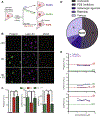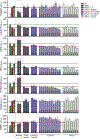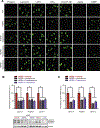A high-content imaging-based screening pipeline for the systematic identification of anti-progeroid compounds
- PMID: 26341717
- PMCID: PMC6317068
- DOI: 10.1016/j.ymeth.2015.08.024
A high-content imaging-based screening pipeline for the systematic identification of anti-progeroid compounds
Abstract
Hutchinson-Gilford Progeria Syndrome (HGPS) is an early onset lethal premature aging disorder caused by constitutive production of progerin, a mutant form of the nuclear architectural protein lamin A. The presence of progerin causes extensive morphological, epigenetic and DNA damage related nuclear defects that ultimately disrupt tissue and organismal functions. Hypothesis-driven approaches focused on HGPS affected pathways have been used in attempts to identify druggable targets with anti-progeroid effects. Here, we report an unbiased discovery approach to HGPS by implementation of a high-throughput, high-content imaging based screening method that enables systematic identification of small molecules that prevent the formation of multiple progerin-induced aging defects. Screening a library of 2816 FDA approved drugs, we identified retinoids as a novel class of compounds that reverses aging defects in HGPS patient skin fibroblasts. These findings establish a novel approach to anti-progeroid drug discovery.
Keywords: FDA-approved compounds; HGPS; High-content imaging; High-throughput screening; Progerin; Retinoids.
Copyright © 2016. Published by Elsevier Inc.
Conflict of interest statement
Conflict of interest
The authors declare no conflicts of interest.
Figures





Similar articles
-
Vitamin D receptor signaling improves Hutchinson-Gilford progeria syndrome cellular phenotypes.Oncotarget. 2016 May 24;7(21):30018-31. doi: 10.18632/oncotarget.9065. Oncotarget. 2016. PMID: 27145372 Free PMC article.
-
Identification of mitochondrial dysfunction in Hutchinson-Gilford progeria syndrome through use of stable isotope labeling with amino acids in cell culture.J Proteomics. 2013 Oct 8;91:466-77. doi: 10.1016/j.jprot.2013.08.008. Epub 2013 Aug 20. J Proteomics. 2013. PMID: 23969228
-
Progerin impairs chromosome maintenance by depleting CENP-F from metaphase kinetochores in Hutchinson-Gilford progeria fibroblasts.Oncotarget. 2016 Apr 26;7(17):24700-18. doi: 10.18632/oncotarget.8267. Oncotarget. 2016. PMID: 27015553 Free PMC article.
-
Epigenetic involvement in Hutchinson-Gilford progeria syndrome: a mini-review.Gerontology. 2014;60(3):197-203. doi: 10.1159/000357206. Epub 2014 Feb 28. Gerontology. 2014. PMID: 24603298 Review.
-
Hutchinson-Gilford progeria syndrome through the lens of transcription.Aging Cell. 2013 Aug;12(4):533-43. doi: 10.1111/acel.12070. Epub 2013 Apr 19. Aging Cell. 2013. PMID: 23496208 Review.
Cited by
-
Human dermal fibroblasts in psychiatry research.Neuroscience. 2016 Apr 21;320:105-21. doi: 10.1016/j.neuroscience.2016.01.067. Epub 2016 Feb 9. Neuroscience. 2016. PMID: 26855193 Free PMC article. Review.
-
Causes and consequences of genomic instability in laminopathies: Replication stress and interferon response.Nucleus. 2018 Jan 1;9(1):258-275. doi: 10.1080/19491034.2018.1454168. Nucleus. 2018. PMID: 29637811 Free PMC article. Review.
-
A High Throughput Phenotypic Screening reveals compounds that counteract premature osteogenic differentiation of HGPS iPS-derived mesenchymal stem cells.Sci Rep. 2016 Oct 14;6:34798. doi: 10.1038/srep34798. Sci Rep. 2016. PMID: 27739443 Free PMC article.
-
An overview of treatment strategies for Hutchinson-Gilford Progeria syndrome.Nucleus. 2018 Jan 1;9(1):246-257. doi: 10.1080/19491034.2018.1460045. Nucleus. 2018. PMID: 29619863 Free PMC article. Review.
-
p300 nucleocytoplasmic shuttling underlies mTORC1 hyperactivation in Hutchinson-Gilford progeria syndrome.Nat Cell Biol. 2024 Feb;26(2):235-249. doi: 10.1038/s41556-023-01338-y. Epub 2024 Jan 24. Nat Cell Biol. 2024. PMID: 38267537 Free PMC article.
References
-
- Bosch-Presegue L, Raurell-Vila H, Marazuela-Duque A, Kane-Goldsmith N, Valle A, Oliver J, Serrano L, Vaquero A, Stabilization of Suv39H1 by SirT1 is part of oxidative stress response and ensures genome protection, Mol. Cell 42 (2011) 210–223. - PubMed
-
- Broers JL, Hutchison CJ, Ramaekers FC, Laminopathies J Pathol. 204 (2004) 478–488. - PubMed
-
- Burtner CR, Kennedy BK, Progeria syndromes and ageing: what is the connection?, Nat Rev. Mol. Cell Biol 11 (2010) 567–578. - PubMed
Publication types
MeSH terms
Substances
Grants and funding
LinkOut - more resources
Full Text Sources
Other Literature Sources
Research Materials
Miscellaneous

